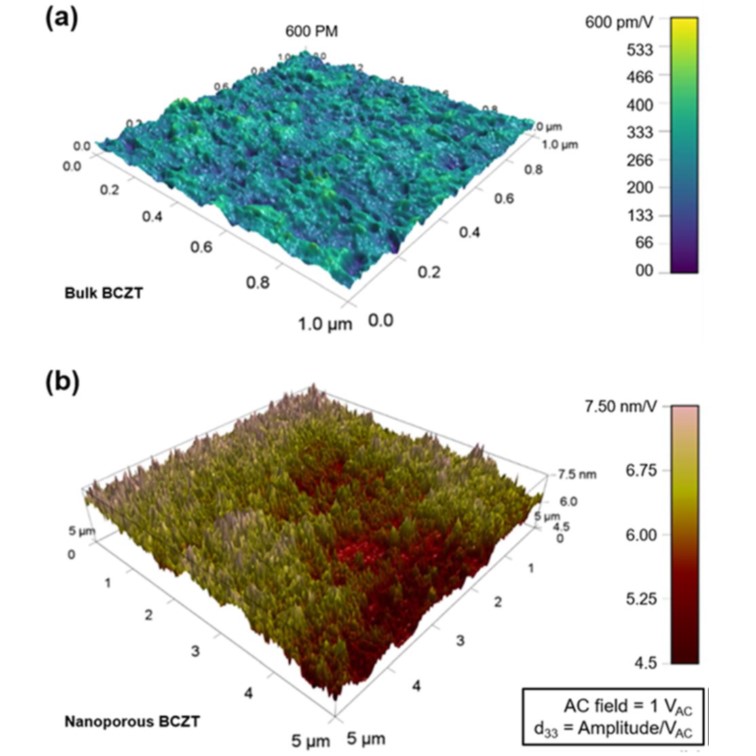Breakthrough Nanoporous Material Exhibits Giant Piezoelectric Response

A promising candidate for future high-density energy harvesting
Recently a super-strain nanoporous material, barium calcium zirconium titanate composition (Ba0.85Ca0.15)(Ti0.9Zr0.1)O3 (BCZT) was created, which showcases an extraordinary piezoelectric response (d33 ≈7500 pm V-1) . This value represents an order of magnitude greater than the traditional piezoelectric materials like lead zirconate titanate (PZT). This study marks the first investigation into the strain dependence of the piezoelectric properties at the nano-level using BCZT. The simple synthesis process coupled with its exceptional piezoelectric capabilities enables nanoporous BCZT to be a highly promising candidate for developing eco-friendly dielectric capacitor and generator for high-density energy harvesting in the future.
Piezoelectric materials, known for their unique ability to generate electric charge in response to mechanical stress or to deform under an electric field, are widely used in sensors, transducers, undersea sonar and small medical diagnostic devices. For over half a century, conventional piezoelectric materials, which are highly toxic and lead-based, have been commercially dominant. "We aimed to invent lead-free piezoelectric materials that offer performance comparable to or even superior to conventional ones. This is not just our goal but a common goal for researchers worldwide. " said Yukana Terasawa, assistant professor from Faculty of Advanced Science and Technology at Kumamoto University, a leading author of this study.
One of the most remarkable features of this novel nanoporous material is its ultra-thin structure, with a thickness of less than 30nm. This characteristic significantly contributes to its high piezoelectricity. The piezoelectric charge constant d, specifically the longitudinal piezoelectric charge constant d33 value of BCZT, reaches an impressive 7500 pm V-1. This is a substantial enhancement compared to conventional lead-based PZT, which has a d33 value of around 650 pC V-1. This highlights BCZT's potential as a superior alternative to PZT, and positions it as the most successful ferroelectric material in the past 50 years.

Piezoresponse (d33) of the Bulk BCZT and Nanoporous BCZT. The amplitude distribution of d33 mapping reveals that the piezoresponse of nonporous BCZT (b) is approximately 10 times greater than that observed for bulk BCZT (a).
In addition to its remarkable piezoelectric properties, this material boasts a straightforward synthesis approach. Traditional methods for synthesizing lead-free barium titanate (BaTiO3, BTO) involve complex remixing, recalcination, or multi-step preparation processes. In contrast, BCZT can be synthesized using a soft-templating method, a sol-gel-based technique that employs a diblock copolymer as a pore-directing agent. This innovative approach simplifies the synthesis process significantly, making it more accessible and efficient.
This groundbreaking advancement not only paves the way for replacing conventional piezoelectric materials with more eco-friendly alternatives, but also opens up new possibilities for developing and applying ferroelectric devices in energy harvesting. With high efficiency in energy harvesting, these innovative devices are expected to become rivals to traditional energy sources like coal and hydrocarbons in the future.
In addition to Dr. Yukana Terasawa from Kumamoto University, this study is contributed by the researchers from The University of Queensland, Nagoya University, Waseda University, Tanta University and National Institute for Materials Science (NIMS).
| Authors |
Motasim Billah, Yukana Terasawa, Mostafa Kamal Masud, Toru Asahi, Mohamed Barakat Zakaria Hegazy, Takahiro Nagata, Toyohiro Chikyow, Fumihiko Uesugi, Md. Shahriar A. Hossain, Yusuke Yamauchi |
| Title of original paper | Giant piezoresponse in nanoporous (Ba,Ca)(Ti,Zr)O3 thin film |
| Journal | ROYAL SOCIETY OF CHEMISTRY |
| DOI | 10.1039/d3sc06712b |

